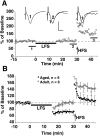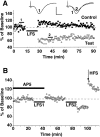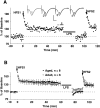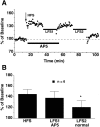Increased susceptibility to induction of long-term depression and long-term potentiation reversal during aging - PubMed (original) (raw)
Increased susceptibility to induction of long-term depression and long-term potentiation reversal during aging
C M Norris et al. J Neurosci. 1996.
Abstract
Homosynaptic long-term depression (LTD) and reversal of long-term potentiation (LTP) were examined extracellularly at CA3-CA1 synapses in stratum radiatum of slices from adult (6-9 months) and aged (20-24 months) Fischer 344 rats. Prolonged low-frequency stimulation (LFS) (900 pulses/1 Hz) of the Schaffer collaterals depressed the initial slope of the excitatory postsynaptic potential (EPSP) in aged but not adult rats. LTD at aged synapses was pathway-specific, persistent, and sensitive to the NMDA receptor antagonist DL-2-amino-5-phosphonopentanoic acid (AP5). Adult slices exhibited AP5-sensitive LTD in high [Ca2+] medium, whereas LTD in aged slices was blocked by high [Mg2+], suggesting that differences in Ca2+ regulation may underlie susceptibility to LTD. Despite age-related differences in LTD induction, no age difference in LTP magnitude was revealed. Additionally, LFS delivered 60 min after LTP induction resulted in similar LTP reversal for both age groups. Susceptibility differences to LTP reversal were indicated after multiple short-duration LFS bursts (30 pulses/1 Hz), with each burst separated by 10 min. Aged synapses exhibited significant reversal after a single burst and complete reversal after three LFS episodes. In adult slices, LTP reversal appeared after the fourth burst, and at no time was LTP depressed to initial baseline levels. This study provides the first characterization of homosynaptic LTD/LTP reversal in the aged animal and demonstrates that one form of plasticity, depression attributable to LFS, is increased during aging.
Figures
Fig. 1.
LTD in aged hippocampal slices is input-specific and durable. A, Plot of EPSP slopes (mean percentage of initial baseline) at CA3–CA1 synapses of an individual aged slice in response to stimulation of the Schaffer collaterals (0.033 Hz). LFS (900 pulses/1 Hz) resulted in a substantial depression of the EPSP slope, and this depression remained until presynaptic fibers were activated with HFS. Thin horizontal bars represent time points at which 10 successive EPSPs were averaged to generate representative waveforms. These average waveforms are depicted in the_inset_. Calibration for this figure and all subsequent figures: vertical 1 mV, horizontal 5 msec. B, Plot of EPSP slopes averaged across aged slices (n = 5) in which a test pathway (filled circles) underwent LFS, whereas a control pathway (open circles) received stimulation at baseline frequency only. The results show that LTD of aged slices is exclusive to the test pathway. Bars represent SEM.C, Responses recorded in the test pathway at 15, 30, 45, and 60 min after LFS were significantly different from the pre-LFS baseline but not from each other, demonstrating that LTD of aged slices is stable at 15 min post-LFS and persists for at least 1 hr. Bars represent SEM. Asterisk indicates difference from pre-LFS baseline (p < 0.05).
Fig. 2.
LTD in the aged rat exhibits sensitivity to AP5. For five aged slices, AP5 (thick horizontal bar) was bath-applied during the delivery of prolonged LFS (LFS1). After washout, LFS in drug-free medium (LFS2) was administered, and responses were followed for another 15 min before delivery of HFS. The results indicated that the ability of LFS to elicit LTD in area CA1 of the aged slice was impaired in the presence of AP5 and that significant LTD was attained only in drug-free medium. Bars represent SEM.
Fig. 6.
Statistical summary of the experiments illustrated in Figures 3, 4, 5. In adult slices (open columns), LTD was nonexistent in normal medium and enhanced in high Ca2+medium. LTD obtained under high Ca2+ conditions for the adult was inhibited by AP5. For aged slices (filled columns), LTD was robust in normal medium but impaired when the bath [Mg2+] was elevated to 4 m
m
.Asterisk indicates a difference from the initial baseline; plus sign indicates a within-age group difference obtained between slices perfused with altered medium (high [Ca2+] or [Mg2+]) and slices perfused with normal medium (p < 0.05). Bars represent SEM.
Fig. 3.
In normal medium, LTD is expressed in slices from aged but not adult rats. A, Plot of EPSP slopes for a single adult slice bathed in normal medium (2 m
m
Ca2+/2 m
m
Mg2+). LFS of Schaffer collaterals failed to depress the synaptic response, although a subsequent burst of HFS was able to instate LTP. _Inset_represents EPSP waveforms averaged at the indicated time points before and after pattern stimulation. B, Average data for slices from six aged rats and six adult rats. All slices were perfused with normal medium. LFS produced a substantial depression of aged CA3–CA1 synaptic responses (filled circles), whereas slices from adults (open circles) showed no signs of LTD. HFS reversed LTD and induced LTP in aged and adult rats, respectively. Bars represent SEM.
Fig. 4.
LTD in slices from aged rats is blocked when the bath [Mg2+] is increased. A, Plot of EPSP slopes recorded in an individual aged slice bathed in high Mg2+ medium (2 m
m
Ca2+/4 m
m
Mg2+). Inset represents EPSP waveforms averaged at the indicated time points before and after LFS. Stimulation that markedly depressed CA1 synaptic responses in aged slices in previous experiments (Figs. 1, 2, 3) failed to do so when delivered in the presence of high [Mg2+] media.
Fig. 5.
AP5-sensitive LTD in adult slices is revealed when the bath [Ca2+] is increased. A, Plot of EPSP slopes recorded in a test (open circles) and a control pathway (filled squares) of an individual adult slice bathed in high Ca2+ medium (4 m
m
Ca2+/2 m
m
Mg2+). After the LFS episode, LTD was observed only in the test pathway.Inset represents EPSP waveforms averaged at the indicated time points before and after LFS. B, Data collected from an adult slice (in high Ca2+) that was perfused with AP5 (thick horizontal bar) during LFS (LFS1). After AP5 washout, another round of LFS (LFS2) was delivered. LTD was observed only after LFS2 (i.e., LFS in AP5-free medium). The depressed response could be potentiated by HFS to the initial baseline level.
Fig. 7.
LTP reversal in area CA1 of aged and adult rats.A, Plot of EPSP slopes for an individual slice obtained from an aged rat. HFS (HFS1) was used to induce LTP, followed 60 min later by LTP-reversal (LFS, 900 pulses/1 Hz). LFS was followed 15 min later by repotentiation (HFS2). Inset represents EPSP waveforms averaged at the indicated time points before and after pattern stimulation. In this slice, LFS reversed LTP to the pre-HFS level, and a subsequent burst of HFS reinstated the potentiated response. B, Average data for slices from aged (filled circles; n = 8) and adult (open circles; n = 6) animals. HFS1 produced similar LTP in both age groups. The potentiated response was also reversed to a similar level by LFS, although adults tended to exhibit residual potentiation. As well, repotentiation attributable to a second episode of HFS (HFS2) was not different between aged and adult rats. Bars represent SEM.
Fig. 8.
LTP reversal in aged slices is long-lasting. Average data for five aged slices in which LTP induction (HFS) was followed 15 min later by LFS. Post-LFS responses were not different from the pre-HFS baseline and remained stable for the duration of the experimental session (45 min). Bars represent SEM.
Fig. 9.
Aged animals are more susceptible to LTP reversal. Responses after induction of LTP (HFS1; double arrow) were similar in aged (filled circles;n = 9) and adult rats (open circles;n = 9). To reverse LTP, short-duration bursts (30 pulses) of LFS (1 Hz; single arrows) were used. After the sixth episode of LFS, another bout of HFS (HFS2; double arrow) was administered. Aged rats exhibited LTP reversal sooner than adults, and the potentiated response in aged slices was reversed completely to pre-HFS1 levels by the third or fourth LFS episode. Bars represent SEM.
Fig. 10.
LTP reversal in aged slices is inhibited by AP5.A, Plot of EPSP slopes for an individual aged slice. LTP (HFS) was established, and AP5 was then introduced to the recording medium. No LTP reversal was observed when LFS was delivered in the presence of AP5 (LFS1). In drug-free media, however, a second episode of LFS (LFS2) resulted in substantial depression. B, Statistical summary for six aged slices in which LTP reversal was attempted in the presence of AP5. Asterisk indicates a difference between LFS2 and LFS1; p < 0.05. Bars represent SEM.
Similar articles
- Age dependence of homosynaptic non-NMDA mediated long-term depression in field CA1 of rat hippocampal slices.
Velísek L, Moshé SL, Stanton PK. Velísek L, et al. Brain Res Dev Brain Res. 1993 Oct 15;75(2):253-60. doi: 10.1016/0165-3806(93)90029-a. Brain Res Dev Brain Res. 1993. PMID: 7903226 - Reversal of age-related alterations in synaptic plasticity by blockade of L-type Ca2+ channels.
Norris CM, Halpain S, Foster TC. Norris CM, et al. J Neurosci. 1998 May 1;18(9):3171-9. doi: 10.1523/JNEUROSCI.18-09-03171.1998. J Neurosci. 1998. PMID: 9547225 Free PMC article. - Differential induction of LTP and LTD is not determined solely by instantaneous calcium concentration: an essential involvement of a temporal factor.
Mizuno T, Kanazawa I, Sakurai M. Mizuno T, et al. Eur J Neurosci. 2001 Aug;14(4):701-8. doi: 10.1046/j.0953-816x.2001.01679.x. Eur J Neurosci. 2001. PMID: 11556894 - Synaptic and Axonal Plasticity Induction in the Human Cerebral Cortex.
Ugawa Y. Ugawa Y. In: Nakao K, Minato N, Uemoto S, editors. Innovative Medicine: Basic Research and Development [Internet]. Tokyo: Springer; 2015. In: Nakao K, Minato N, Uemoto S, editors. Innovative Medicine: Basic Research and Development [Internet]. Tokyo: Springer; 2015. PMID: 29787180 Free Books & Documents. Review.
Cited by
- Insulin-like growth factor-1 in CNS and cerebrovascular aging.
Sonntag WE, Deak F, Ashpole N, Toth P, Csiszar A, Freeman W, Ungvari Z. Sonntag WE, et al. Front Aging Neurosci. 2013 Jul 2;5:27. doi: 10.3389/fnagi.2013.00027. eCollection 2013. Front Aging Neurosci. 2013. PMID: 23847531 Free PMC article. - Secrets of aging: What does a normally aging brain look like?
Barnes CA. Barnes CA. F1000 Biol Rep. 2011;3:22. doi: 10.3410/B3-22. Epub 2011 Oct 3. F1000 Biol Rep. 2011. PMID: 22003369 Free PMC article. - Perineuronal Nets Restrict the Induction of Long-Term Depression in the Mouse Hippocampal CA1 Region.
Khoo GH, Lin YT, Tsai TC, Hsu KS. Khoo GH, et al. Mol Neurobiol. 2019 Sep;56(9):6436-6450. doi: 10.1007/s12035-019-1526-1. Epub 2019 Mar 2. Mol Neurobiol. 2019. PMID: 30826967 - Glutamate receptor-mediated restoration of experience-dependent place field expansion plasticity in aged rats.
Burke SN, Maurer AP, Yang Z, Navratilova Z, Barnes CA. Burke SN, et al. Behav Neurosci. 2008 Jun;122(3):535-48. doi: 10.1037/0735-7044.122.3.535. Behav Neurosci. 2008. PMID: 18513124 Free PMC article. - Developmental changes of TrkB signaling in response to exogenous brain-derived neurotrophic factor in primary cortical neurons.
Zhou X, Xiao H, Wang H. Zhou X, et al. J Neurochem. 2011 Dec;119(6):1205-16. doi: 10.1111/j.1471-4159.2011.07528.x. Epub 2011 Nov 3. J Neurochem. 2011. PMID: 21988201 Free PMC article.
References
- Alger BE. Gating of GABAergic inhibition in hippocampal pyramidal cells. Ann NY Acad Sci. 1991;627:249–263. - PubMed
- Barnes CA, McNaughton BL. An age comparison of the rates of acquisition and forgetting of spatial information in relation to long-term enhancement of hippocampal synapses. Behav Neurosci. 1985;99:1040–1048. - PubMed
- Barnes CA, Rao G, Foster TC, McNaughton BL. Region-specific age effects on AMPA sensitivity: electrophysiological evidence for loss of synaptic contacts in hippocampal field CA1. Hippocampus. 1992;2:457–468. - PubMed
- Barnes CA, Treves A, Rao G, Shen J. Electrophysiological markers of cognitive aging: region specificity and computational consequences. Semin Neurosci. 1994;6:359–367.
- Barrionuevo G, Schottler F, Lynch G. The effect of repetitive low frequency stimulation on control and potentiated synaptic responses in the hippocampus. Life Sci. 1980;27:2385–2391. - PubMed
Publication types
MeSH terms
Substances
LinkOut - more resources
Full Text Sources
Other Literature Sources
Medical
Miscellaneous









